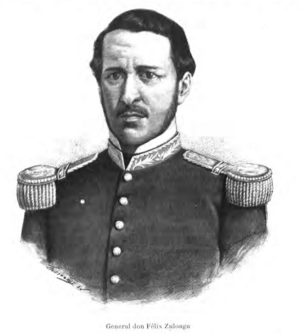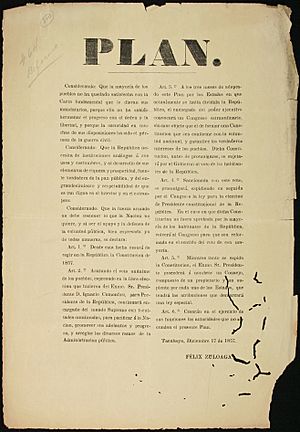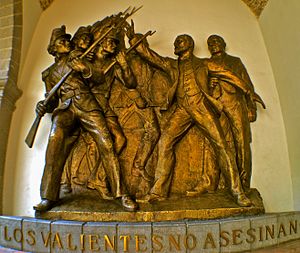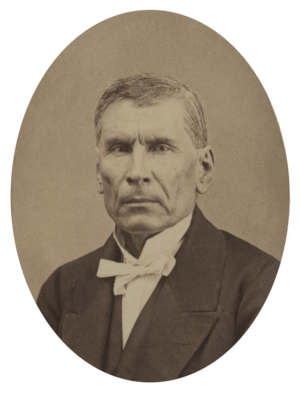Félix María Zuloaga facts for kids
Quick facts for kids
Félix María Zuloaga
|
|
|---|---|
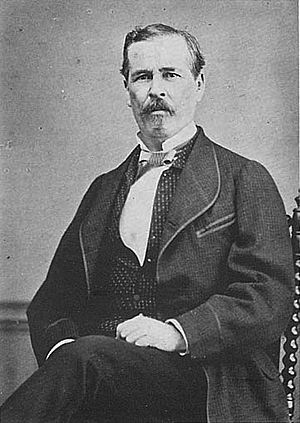 |
|
| 27th President of Mexico by the Plan of Tacubaya |
|
| In office 11 January 1858 – 24 December 1858 |
|
| Succeeded by | Manuel Robles Pezuela |
| Personal details | |
| Born | 31 March 1813 Álamos, Sonora, New Spain |
| Died | 11 February 1898 (aged 84) Mexico City |
| Nationality | Mexican |
| Political party | Conservative |
Félix María Zuloaga was a Mexican general and politician. He was a conservative who became very important at the start of the Reform War in 1858. This war led him to become the president of Mexico. President Zuloaga was not recognized by the liberals, who supported President Benito Juarez, and they fought against each other.
Zuloaga's forces quickly took control of the capital city and many central states. They won most of the big battles during the first year of the war. They even captured Juarez and his entire team for a short time. But the liberals were not completely defeated. They still controlled large parts of the country, and Juarez stayed safe in the important port city of Veracruz.
In December 1858, a group of moderate conservatives removed Zuloaga from power. They hoped to make peace with Juarez. Manuel Robles Pezuela then became president. However, the liberal government refused to make any deals. So, the conservatives then chose Miguel Miramon as their new president. Zuloaga, who still thought he was the rightful president, supported Miramon's election and officially gave him the presidency.
Zuloaga stayed somewhat involved in Miramon's government but later stepped away. After the war ended, he tried to claim the presidency again while conservative fighters were still active. But this attempt failed, and Zuloaga left Mexico. He came back during the Second Mexican Empire, but he did not play any political or military role. After the Empire fell in 1867, Zuloaga was sent away to Cuba. He later returned to Mexico and lived a quiet life until he died in 1895.
Contents
Early Life and Military Career
Félix Zuloaga was born on March 31, 1813, in Álamos, Sonora.
In 1834, he became a colonel in the national guard. He fought in campaigns against native groups until 1837. He then left Chihuahua and was given the rank of lieutenant of engineers.
He defended the government during a rebellion in 1840. In this rebellion, a group of fighters took over the National Palace and held President Anastasio Bustamante hostage. They wanted to overthrow the government and bring back an older constitution. The next year, Zuloaga joined a plan called the Bases of Tacubaya. This plan aimed to change the constitution that was in place at the time. He was promoted to captain in 1841. He fought in Yucatan during the Caste Wars, then moved to Tabasco and became a lieutenant colonel.
During the Mexican–American War, he was in charge of building defenses in Monterey and Saltillo. In 1847, he helped set up defenses on the road from Veracruz to Mexico City.
In 1848, he retired to Chihuahua. He was elected as an alderman (a city council member) in 1852. He stayed in this job until 1853, when he returned to the military. In November, he became a colonel. He was also made president of a special court that judged thieves. For a few months, he served in this role. In the next two years, he fought for Santa Anna against liberal rebels led by Juan Alvarez. He was captured, but the rebel leader Ignacio Comonfort saved him from being executed. Comonfort even convinced Zuloaga to join the liberal side. When the Plan of Ayutla succeeded and Santa Anna's rule ended, Zuloaga was given command of Comonfort's forces. He was sent to fight in the Sierra de Queretaro.
The Reform Era Begins
Zuloaga's former commander, Ignacio Comonfort, became president in December 1856. His time as president was very busy. A new constitution was finished in early 1857. But it faced strong opposition from conservatives. They did not like its new rules against the army and the church.
One big issue was the Ley Lerdo. This law forced groups to sell their properties. This affected both the Catholic Church and Mexico's Indigenous communities, who traditionally farmed on shared lands. More problems arose when the government said that all public workers had to swear an oath to the new constitution or lose their jobs. Many Catholics refused this oath, and those who did not were removed from the church.
Zuloaga was loyal to Comonfort's moderate liberal government at first. He helped lead government efforts to stop a conservative rebellion in Puebla. As tensions grew over the constitution, Comonfort left the capital. He stayed temporarily in Tacubaya, where Zuloaga commanded his defenses.
However, by December, Zuloaga was suspected of planning against the government and was even accused.
The Plan of Tacubaya
The suspicions about Zuloaga were correct. He was indeed plotting with conservative groups. After making deals with some governors, the plotters in a Mexico City suburb announced the Plan of Tacubaya on December 17. This plan aimed to get rid of the national constitution.
The plan said that Ignacio Comonfort would be in charge of the government. He would have three months to call a new congress. This congress would write another constitution that would be more in line with what the country wanted. This new constitution would then be voted on by the people. The president would rule with a council that had one representative from each state.
On December 17, the congress strongly protested against the Plan of Tacubaya. They said that Comonfort's power had ended. Zuloaga's soldiers took over the capital and closed the congress. Benito Juarez, who was president of the Supreme Court, and Isidoro Olvera, president of the congress, were arrested. The city council of Mexico City was also dissolved. On December 19, Comonfort officially announced that he accepted the Plan of Tacubaya. He explained that he saw the plan as a chance for a moderate solution, believing the other option was chaos.
Seventy members of congress met again in Queretaro and protested. A council of state was set up on December 25. Some members thought it would be impossible to bring about the peace that Comonfort wanted. On December 30, the important state of Veracruz rejected the Plan of Tacubaya. This made Comonfort realize his new government was in trouble. Comonfort resigned, passing the presidency to Benito Juarez, whom Comonfort had also released. Comonfort gathered his loyal troops and fought some small battles with Zuloaga's government. But most of Comonfort's soldiers eventually left him, causing him to flee the capital and then the country.
Zuloaga's Presidency

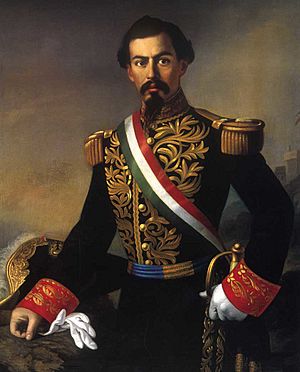
After winning a small fight with Comonfort, Zuloaga announced on January 21 that he would bring order to the capital. He then named the people chosen for a special group that would pick the new head of state, as planned by the Plan of Tacubaya. On January 22, this group met and chose Félix Zuloaga as president with 26 votes. The next day, Zuloaga took an oath, promising to protect Mexico's independence, religion, and unity.
The new conservative government was recognized by foreign diplomats in the capital, except for the United States.
On January 24, Zuloaga named his ministers (like cabinet members). He then named a council of government with two representatives from each state.
On January 28, a new rule was announced that canceled the Ley Lerdo. It also called for church property that had been taken to be returned. Other rules on the same day gave back jobs to all public workers who had lost them for not swearing an oath to the 1857 constitution. They also canceled the Ley Juarez. On January 31, President Zuloaga wrote a letter to Pope Pius IX, saying that Mexico was still loyal to the Catholic faith.
States in Mexico began to declare their loyalty to either Juarez or Zuloaga. Their armies prepared for war. Zuloaga knew how important Veracruz was. He tried to get the governor of Veracruz, Manuel Gutiérrez Zamora, to support him. But the governor said he supported Juarez. Meanwhile, liberal forces in the north were organized by Santiago Vidaurri. Manuel Doblado led a liberal group in the central part of the country. On March 10, 1858, the liberals lost the Battle of Salamanca. This defeat allowed the conservatives to move into the country's interior.
Juarez was in Guadalajara when part of the army there rebelled and imprisoned him. At one point, they threatened to kill him. But his fellow liberal minister, Guillermo Prieto, convinced the soldiers not to shoot Juarez. As different groups fought for control of the city, Juarez and other liberal prisoners were released. Guadalajara was fully captured by conservatives by the end of March. Juarez then made Santos Degollado the head of his armies. He decided to go to Veracruz, traveling from Manzanillo, crossing Panama, and arriving in Veracruz on May 4, 1858.
On July 24, Miramon captured Guanajuato. San Luis Potosi was captured by conservatives on September 12. Vidaurri was defeated at the Battle of Ahualulco on September 29. By October, the conservatives were at their strongest point.
The conservatives controlled most of the big cities. The liberal capital of Veracruz was cut off from the rest of the country. However, the liberals still had the loyalty of many parts of the north and south. Juarez was determined to keep fighting. He stayed safe in the important port of Veracruz, which the conservatives could not block by sea.
Even with his big victories, Zuloaga's government was not completely safe. An attempt to bring back the old system of dividing the country into departments (instead of states) was not popular. Conservatives were also divided into three groups:
- Santanistas: wanted a stronger government like when Santa Anna was in power.
- Zuloaguistas: wanted Zuloaga to stay president.
- Fusionists: wanted to make peace with the liberals.
Zuloaga's government also struggled to find money. Money from the church, forced loans, and higher taxes were not enough to pay for government costs. Taking people's property also made citizens and foreigners angry.
The Plan of Tacubaya had called for a congress to write a new constitution. But this was hard to do in the middle of a war. Zuloaga's cabinet wrote a temporary constitution.
In July 1858, the failure to win a final victory over the liberals led to changes in the cabinet. New ministers were named for different government departments. A law against plotters was passed, and there were also limits on the press.
The conservatives kept winning battles. On July 24, Miramon captured Guanajuato. Some moderate liberals now wanted to make a deal with the conservatives. On September 29, the conservatives won an important victory at Ahuahulco against Santiago Vidaurri. By October 1858, the conservatives were at their strongest.
In early November, Zuloaga's minister of Government offered to resign, but it was not accepted. The liberals then took Guadalajara, which caused worry in Mexico City. Zuloaga often met with British and French representatives. These two countries seemed willing to help block Juarez. However, Juarez had already gained the support of the United States. The U.S. minister, Forsyth, refused to recognize Zuloaga's government.
On December 20, 1858, about a year after he first came to power, Zuloaga faced a rebellion against himself. Echeagaray announced a plan in Ayutla to call a congress to write a new constitution. Zuloaga took steps to stop the revolt. He took personal command of the forces in the capital and forbade any talks with the rebels. He issued a statement condemning Echeagaray, who was removed from his army position. Manuel Doblado was also arrested.
A changed version of the Ayotla Plan was announced by Manuel Robles Pezuela on December 23. This plan gained some military support in the capital. Zuloaga offered to resign if the problem was just with him. But he would not agree if the plan was meant to get rid of his conservative ideas. Miramon was offered command of the plan, but he refused.
As loyal troops continued to leave him, Zuloaga resigned before midnight. He sought safety with the British embassy, even though the rebels promised he would not be harmed. The Plan of Ayotla was actually from the "fusionist" party, a moderate group. They did not want to give up conservative ideas, but they wanted to end the war by finding a compromise with the liberals. Manuel Robles Pezuela arrived at the national palace on the morning of December 24 and became president.
Robles Pezuela sent people to get support for his plan. He began to gather a group of representatives. However, he ignored the conservative hero Miguel Miramon, which upset strong conservatives. Robles eventually agreed to give Miramon a place in the group.
The group met on December 30, 1858, and chose a president. Miramon won with 50 votes against Robles' 46. Robles was allowed to act as temporary president until Miramon arrived in the capital.
Meanwhile, Zuloaga had taken back his resignation. But because of the situation, he officially passed the presidency to Miramon on January 31, 1859. To keep him from changing his mind, Miramon sent him away from the capital. Zuloaga then left the government.
Miramon then fought the war with great energy. He tried twice to capture Juarez's capital in Veracruz. His second attempt in March 1860 failed when his ships were stopped by the U.S. navy, which was protecting Juarez. Liberal victories then increased until Juarez took back the capital in January 1861. However, conservative fighters, especially Leonardo Marquez, remained active in the countryside.
Later Life
In 1861, while conservative forces were still active, Zuloaga appeared again. He claimed the presidency once more, but it did not work. He left the country again the next year. He returned to Mexico in August 1864, during the Second Mexican Empire. But he no longer played any role in politics. He survived the fall of the Empire but was sent away to Cuba. He returned to Mexico after the death of Benito Juarez. Zuloaga became a tobacco merchant and lived until 1895.
See also
 In Spanish: Félix María Zuloaga para niños
In Spanish: Félix María Zuloaga para niños


